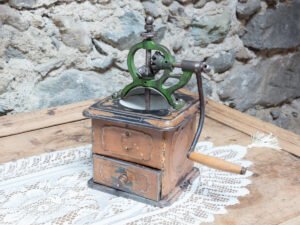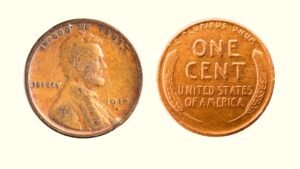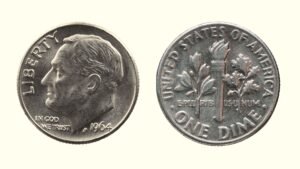The 1941 Lincoln Wheat Penny might look like a regular copper cent at first glance, but this common-looking coin can fetch an amazing price of as high as $9,600. Minted during the early years of World War II, this penny holds great historical and monetary significance in the collectors’ world.
However, if you don’t know what features impact and inflate its worth, you might sell your old and valuable 1941 Penny for nothing. In this guide, I will educate you about all the crucial factors, such as coin condition, mint errors, rare mint marks, and colors, that decide whether your penny is worth a big fortune!
History of the 1941 Lincoln Wheat Penny
The 1941 Lincoln Penny was part of the long-running Lincoln Cent series that began in 1909. It was minted during a pivotal year in American history, as the United States entered World War II.
These pennies were among the last to be made primarily of copper before wartime metal shortages necessitated a change in composition. Eventually, in 1943, the U.S. Mint switched to producing zinc-plated steel pennies to conserve copper for the war effort.
The 1941 penny featured the familiar design by Victor D. Brenner, with Abraham Lincoln’s portrait on the obverse and wheat stalks on the reverse. This design had been in use since 1909 and would continue until 1958 when it would be replaced by the Memorial Cent featuring Lincoln Memorial on the reverse.
| 1941 Lincoln Penny | Key Features |
| Coin Composition | Bronze (95% Copper, 5% Tin & Zinc) |
| Minting Location | Philadelphia, Denver & San Francisco |
| Year of Minting | 1941 |
| Face Value | One-cent |
| Weight | 3.11 grams |
| Diameter | 19.05 mm |
| Thickness | 1.52 mm |
| Designer | Victor David Brenner |
| Mint Marks | No Mint Mark (Philadelphia Mint) D-mint mark (Denver Mint) S-mint mark (San Francisco Mint) |
| Total Mintage | 1,108,078,000 |
Identifying a 1941 Lincoln Wheat Cent (Design Details & Composition)
You can easily identify a 1941 Wheat Penny with its traditional Lincoln wheat cent design:
1941 Lincoln Penny Obverse (Heads):
- The profile of Abraham Lincoln, the 16th U.S. President
- The words “IN GOD, WE TRUST” written on the top, along the edge
- The word ‘LIBERTY’ on the left side
- The mint date ‘1941’ on the bottom right side
- The mint mark “S” or “D” (if present) below the mint year
1941 Lincoln Penny Reverse (Tails):
- The “E. PLURIBUS UNUM” phrase written on the top, along the edge
- The words “ONE CENT” at the center
- Words “UNITED STATES OF AMERICA” written right below the face value/denomination
- Two wheat ears surrounding the words “ONE CENT” and “UNITED STATES OF AMERICA”
Coin Composition & Dimensions:
The 1941 Lincoln Wheat Penny is composed of Bronze Alloy, which is 95% copper and 5% tin and zinc. This was the standard composition for pennies of this era, giving the coin its distinctive reddish-brown coppery color.
The high copper content makes the 1941 pennies relatively heavier than modern steel pennies, weighing about 3.11 grams. Besides, the coin has a diameter of 19.05 millimeters and a thickness of 1.52 mm with a plain edge.
Find the 1941 Lincoln Wheat Penny Value (5 Key Factors)
The value of an old 1941 Wheat Cent can range from $10 to $5,000 or more depending on several factors, such as condition, rarity, and coin errors. Let’s understand these factors in detail.
1. Mintage & Mint Marks
The mintage of the 1941 Lincoln Penny was substantial, reflecting its high demand despite the wartime. Over 1.1 billion pennies were struck across three different mints in 1941. However, this high mintage also makes the 1941 wheat pennies quite common and less valuable than several other pennies from this era.
- 1941 Lincoln Penny No Mint Mark: The Philadelphia Mint, which produced coins without a mint mark, was responsible for the highest mintage of 887+ million pennies in 1941. Despite its abundant availability, the 1941-P Wheat Cents are generally worth $1,000 – $6,000 in commonly found mint state grades, such as MS66 and MS66+.
- 1941-D Lincoln Penny: The Denver Mint, identified by the “D” mint mark on the obverse, produced 128,700,000 pennies in 1941. The value of 1941-D pennies is surprisingly less, with high mint grades, like MS67 and MS67+ examples, fetching $80 to $900.
- 1941-S Lincoln Penny: The San Francisco Mint had the lowest production of the three facilities for 1941, striking 92,360,000 pennies. These coins can be spotted with the “S” mint mark. Despite being the lowest mintage, these cents are only worth $100 to $1,000 in high-grade mint states like MS67 and MS67+.
| 1941 Lincoln Penny Mint Marks | Total Mintage |
| 1941-P Lincoln Penny (no mint mark) | 887,018,000 |
| 1941-D Lincoln Penny | 128,700,000 |
| 1941-S Lincoln Penny | 92,360,000 |
2. Coin Grade & Condition
The condition and grading of a 1941 Lincoln copper penny significantly impact its value, with higher-grade coins commanding premium prices due to their rarity. The highest grade MS68 1941 wheat cent sold for an auction record price of $9,600 on Stack’s Bowers.
Here’s a 1941 Lincoln Penny value chart to find the coin’s average value based on coin grades.
| Coin Grading | 1941-P Penny | 1941-D Penny | 1941-S Penny |
| Poor (0) to Extremely Fine (XF45) | A few cents | A few cents | A few cents to $2 |
| Almost Uncirculated (AU50) to Mint State (MS60) | Below $5 | Below $10 | Below $10 |
| Mint State (MS60 – MS66+) | $5 – $30 | $10 – $60 | $10 – $60 |
| Mint State (MS67 onwards) | $50 – $2,280 (MS68) | $80 – $900 | $85 – $1,000 |
3. Rare Minting Errors in 1941 Lincoln Cent
Apart from coin condition and mint marks, the value of a 1941 wheat cent also largely depends on the mint errors. As of now, the following valuable error coins have been discovered on a 1941 penny.
1941 Doubled Die Obverse (DDO)
This error occurs when the die strikes the coin twice, slightly out of alignment. On 1941 pennies, you can see doubling on inscriptions like “LIBERTY” and “IN GOD WE TRUST” on the obverse.
This minting error can almost double the price of a 1941 penny, with the brown mint state coins ranging from $200 to $300 and the red ones fetching around $500 to $5,000+. One MS66+ example of a 1941 1C DDO coin sold for $5,875 on Heritage Auctions.
Broadstruck Error
This error results when the collar containing the planchet during striking is not in place, allowing the metal to spread outward. A 1941 Lincoln Penny with Broadstruck error can sell for premium prices depending on the coin grading and toning.
1941-S Penny Slanted 1 Error
This rare error is found only on some 1941-S pennies, where the last digit “1” in the mint date is slightly shifted to the left. A VF35 and BN-graded 1941 1C coin with Slanted 1 error sold for almost $28, according to PCGS. A regular 1941-S wheat cent with this grade is only worth $1 to $5.
1941-S Repunched Mint Mark
As the name suggests, this error occurs when the mint mark is punched multiple times, often slightly offset, resulting in the doubling of the letter. In 1941, this error was seen in some of the cents struck by the San Francisco Mint.
4. Color Colors & Toning
The 1941 Lincoln penny, like other copper coins, can be categorized into three distinct color designations: Red, Red and Brown, and Brown. These color designations are important factors in determining the coin’s value.
- Red (RD): Red 1941 wheat pennies are those that have retained at least 95% of their original mint luster. They appear bright and coppery, with minimal toning or discoloration. These cents are generally worth thousands of dollars in high-grade mint states.
- Red and Brown (RB): These pennies retain between 5% to 95% of their original red color, showing a mix of red and brown toning on the surface. RB-graded 1941 pennies are worth slightly less than full red specimens.
- Brown (BN): Brown pennies have less than 5% of their original red color remaining. The copper has fully toned to a brown color due to oxidation. BN-graded 1941 Lincoln pennies are worth the least.
5. 1941 Lincoln Copper Penny Proof Coins
Apart from regular pennies, the Philadelphia Mint also struck 21,100 proof pennies in 1941 for coin collectors. These 1941 proof coins are struck using specially polished dies, resulting in a mirror-like, matte finish. This gives the coins a unique high-contrast appearance with sharp details, which increases their worth.
Besides, the 1941 proof coins are also further graded as RD, RB, and BN based on the toning. The RD-graded proofs are worth the most, fetching up to $1,500 to $8,000 based on PR grades. The RB-graded proof cents are worth $1,000 to $3,000, and BN-graded proof cents are worth $400 to $800.

Expert Tips to Spot a Fake 1941 Wheat Reverse Penny
Since the 1941 proof and error pennies are valuable, some fraud sellers are likely to sell off fake coins as “rare.” In order to spot these 1941 Lincoln Penny counterfeits, follow these simple steps:
- Examine the Weight and Dimensions: Authentic 1941 Lincoln pennies should weigh approximately 3.11 grams and have a diameter of 19.05 mm. If a penny deviates from these numbers, it’s likely fake.
- Verify the Composition: The coin should be composed of 95% copper and 5% tin and zinc. Fake cents may have a different composition, which can be detected using a metal analyzer or a simple magnet test.
- Verify the Mint Marks and Their Placement: If present, the mint mark on the 1941 penny must be placed below the mint date on the obverse. Look for signs of added mint marks, such as irregularities around the mint mark area.
- Analyze the Design Details: Compare the coin’s design to known genuine examples. Pay close attention to Lincoln’s profile, the wheat stalks, and the lettering. Real coins will have sharp, well-defined details, while fakes are blurry.
Overall, while most 1941 Lincoln cents in circulation are worth only a few cents, those in pristine condition or with rare mint errors can command significant premiums. And as you explore the world of Lincoln cents, don’t forget to check out other valuable pennies, such as the 1909 VDB penny, 1919 penny, and 1943 penny, that might be hiding in your change!









